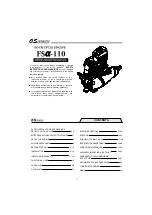
TSLM - M601 Operational & Install Manual
Automatic Protection Limiting
The TSLM provides automatic engine limiting when it restricts fuel to the engine by activating the
EHT valve. The EHT light (if installed) will come ON whenever limiting is performed. Limiting is
restricted to only the start and beta-propeller speed limiting. Limiting may also be disabled, by an
external limiter enable / disable switch (see page 19 for its
electrical circuit
).
Start Limiting
During the start process the engine’s temperature (ITT) can be exceeded – more so when it is
started without any form of limiting (no activation of the EHT). The amount of limiting required vary
according to conditions such as outside air temperature, altitude, battery charge and initial ITT. The
TSLM utilizes an algorithm to control both the rate of rise and the absolute value of the inter-turbine
temperature (ITT).
If you have forgotten the limiter enable / disable switch (if installed) in the disable position when
initiating a start attempt, the TSLM's pre-start checks will detect it, decline the start attempt and
inform you via the TSLM light as to the problem. See the section on initiating a start for more.
Beta & Reverse Propeller Limiting
To prevent a propeller exceed in Beta mode as well as to ensure effective reverse thrust
application, the TSLM will limit the propeller speed (N2) while in BETA mode. The TSLM knows the
propeller is in beta mode by sensing the BETA micro-switch.
Anti-Flameout Operation (AFO)
In anti-flameout operation the igniters and ignition fuel valves are continuously activated as a
precautionary measure against engine flameout. This mode is manually activated by the pilot when
the engine has already been started (is running) by depressing the START switch for at least one
second before releasing it. The TSLM status light will light up to indicate that the AFO mode has
been entered. To deactivate this mode in-flight, the pilot depresses the RUN switch for at least one
second before releasing it. The TSLM status light should go out indicating the anti-flameout mode
has been exited. See also
Determining Engine State
.
Determining Engine State
The TSLM mainly uses the N1 (NG) parameter to determine whether the engine is
running
or
not-
running
(above 50% N1 means
running
and below means
not-running
). This engine state is
important since it impacts the start-run switch functionality. If not-running the start-run switch(es)
initiate
start
and
run
sequences, while if the engine is running the switch(es) activate and
deactivate
anti-flameout operation
(AFO). This is why proper N1 wiring and signaling to the TSLM
is emphasized and why we have a dedicated
TSLM light code
for
N1 error
. The TSLM has an
alternative to determine engine state if for example N1 become disconnected or the tach-generator
ceases to provide an alternating signal. In this alternative (where N1 will read zero) both the ITT
and N2 parameters need to be above 400 (400 °C ITT and 400 rpm N2) for the engine state to be
considered as
running
.
06/29/16
© 2016 VR Avionics
page 8 of 33









































